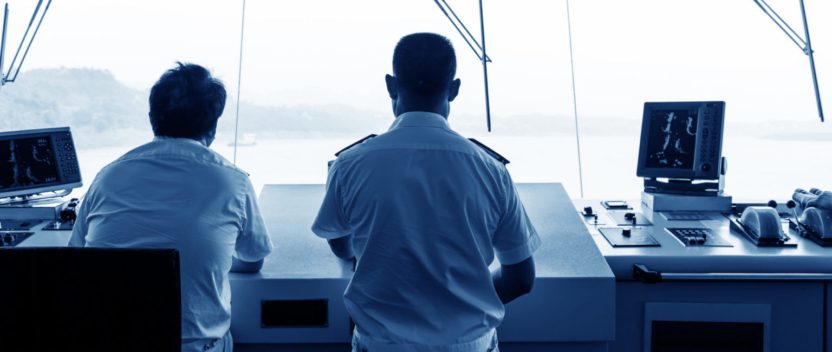How many futurists does it take to change an industry?
Kate Adamson describes herself as a ‘Blue Futurist’ and in convincing the shipping industry that it needs to adapt its mindset and business model, it’s safe to say she has her hands full. Used to taking on rooms of the sceptical, she has a simple message for the shipping industry – change yourself or prepare to be changed.
Shipowners like to say their business is all about reading the opportunity correctly, but the evidence, based not just on its woeful financial and customer performance, but also the scale of the potential disruption, suggests the industry would be well advised to listen.
Many continue to believe that the changes happening elsewhere in the economy are not about their business. Adamson is keen that they understand why this thinking is wrong and what happens when you ignore the warning signs.
Disruptive tech companies – Uber, Spotify, Google – create value for their stockholders but can destroy value in the industries they disrupt. How does an ‘old economy industry’ like shipping square that circle? Adamson says it’s important to understand why such companies are so successful.
“We describe them as disruptive tech companies, but actually technology is only an enabler. The really successful disruptive tech companies have a relentless focus on creating value primarily for customers. They begin with solving the customer’s problem and work back from there.”
The understanding that creating real value for their customers will ultimately translate into shareholder and wider corporate and social value sounds pretty fundamental, but Adamson is concerned that just like music and publishing, shipping will try to protect legacy operations and value rather than adapting to and servicing changing customer requirements. “Neither were successful, and shipping won’t be either if it tries.”
She also takes issue with the idea that disruptive companies will destroy value in shipping, suggesting that its business model is already doing the job quite well. “Over the past 15 years the sector’s return on net assets has been about 3% compared to 9% in the S&P 500. That’s nowhere near enough to cover the 7% cost of capital required to finance the assets deployed. So in reality what’s destroying value is the status quo.”
In the same way, the current structure of the shipping industry with its deep family heritage and historically private ownership is one of its greatest vulnerabilities. Hierarchical management not only fosters a lack of diversity in both culture and thinking but is likely to value gut-feel over analytics, she says.
For these companies, the counterweight of evidence is building, in the growing number of millennials reaching senior positions, the decoupling of shipping cycles from economic growth and the influence of new finance sources backing ideas which solve real-world needs.
Certainly the current economic performance of shipping is woeful, with red ink splattering the balance sheets of all but the tanker owners and seven years on from the financial crisis, Adamson says it’s beginning to dawn on people that this is a new normal. Private equity, which now has experience of shipping, is working with technology innovators, who have realised that logistics and shipping is fertile territory for massive disruption.
“The bottom line is that shipping is failing to deliver on the most basic level,” she says. “It is not capable of providing an acceptable service to its customers at a profit, relying on asset plays and market speculation instead. The ownership structures of legacy shipping companies may well be responsible for some of those problems, but ultimately they won’t prevent them being corrected.”
So how does shipping build a bridge to this new economy? Can it even do so when the forces of change are so great and the ability to adapt, either in terms of hardware or mindset has proved so elusive? Adamson characterises the challenge as the difference between the linear economy that has been in place since the industrial revolution and the exponential one we are entering in the 21st century.
The linear advances experienced to date gave comfort of a manageable implementation timeline as change gradually built and companies were able to adapt. But as technology moves exponentially it becomes exceptionally difficult to model accurately – something shipping has always relied upon to provide supply and demand forecasts.
In this environment, she says adopting the traditional ‘wait and see’ attitude or needing to see a demonstration that someone else has been successful before considering it, is in itself, unacceptably risky.
The danger for an industry where technology adoption has traditionally been driven by compliance is obvious. “The real problem is that those who don’t start broadening their understanding and making changes will see the competitors which do accelerate away from them very fast.”
As such she says, shipping shouldn’t expect a bridge, but instead a one-way elevator.
“It’s leaving soon and not everyone will manage to get on it. The price of a place is the willingness to disrupt your own business before someone else does, or reinvent that disruptive idea for yourself. Look at both Ford and BMW launching their own Uber-type car-lending services in the UK and US. That’s the kind of thinking maritime needs.”
This goes to the heart of shipping’s long term problem, that despite what the well-intentioned may desire, its operational ethos is the zero sum game that works against the sharing economy theory. Even those who advocate sharing operational data for the common good tend to be persuaded against it and such pooling of information as takes place is sanitised to prevent anonymity being compromised.
Adamson firmly believes that the adversarial relationships between carriers, charterers and customers that are embedded into the way shipping does business aren’t tenable in the long run and that transparency, connectivity and data will change them.
New relationships are needed with cargo-owners, charterers and lenders that create value in companies, not just assets. As shipping generates and analyses more data it will be able to start building business cases that are evidence based and which P/E and others are willing to fund.
“Technology and its adoption is going to be a core competence of every company going forward, especially in shipping. Shipping could have access to all the information it needs to reinvent itself,” she says. “It is becoming information-enabled and the lesson is that this first brings transparency, then discovery, and then enables the big idea.”
Adamson’s company Futurenautics exists to try and level the playing field for maritime companies attempting to make sense of the threats and opportunities. But she says many in shipping still believe that making money in shipping is more about asset play through counter-cyclical investments than it is on meeting customer needs. It’s not a model that can endure.
“Odds are [the change] will be from outside. There are leaders in the industry capable of having that vision, but they are up against a prevailing mindset which is dangerously complacent. Changing that mindset is probably the greatest challenge we face.”
Ends


